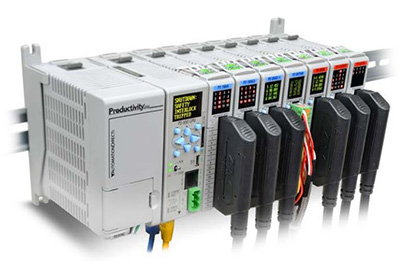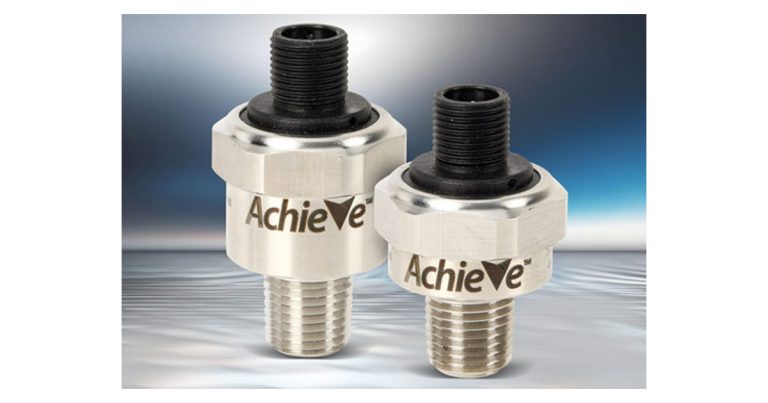PLCs and PACs Simplify Data Acquisition: Powerful PLCs and PACs Have Built-in Data Acquisition, Data Logging and Data Analysis Functionality

January 18, 2022
By Jeff Payne, Product Manager, PLC, I/O and PC-based Controls, AutomationDirect
Data acquisition, data logging and data analysis are required functions for most modern industrial control systems. The simplest and lowest cost way to provide these functions is often by using the same platform that’s providing real-time control—namely the PLC or the programmable automation controller (PAC).
A few years ago, this wasn’t possible as PLCs lacked the required processing power and data storage capability. But more powerful PLCs and the evolution of PACs has made it possible to perform many data acquisition tasks within the controller—saving money and providing an overall simpler system.
PLCs have been controlling machines and processes for more than 30 years. Demand for data and the need for real-time process information has increased during this time, and continues to grow rapidly in nearly every industry.
End users need intelligence about their processes, machines and manufacturing operations. They need to know about system alarms and events, about process variables, and about production amounts. They need this information to make better manufacturing and business decisions in real time.
Historically, acquisition of and access to this information was available only via applications with high-priced standalone supervisory control and data acquisition (SCADA) systems, third-party software, or expensive PC-based systems. But many modern PLCs and PACs now have built-in data acquisition, data storage and networking capabilities—so accessing this critical information can be as simple as connecting a PLC’s Ethernet port to a network, or pulling data from a removable USB mass storage device such as a USB pen drive.
But this hasn’t always been the case. In the past, extracting data was a lot more difficult, and much more expensive.
Data Acquisition Roots
Originally, SCADA systems performed monitoring and control of geographically dispersed system such as power transmission lines, oil and gas pipelines, water/ wastewater systems, and the like. Older SCADA systems used remote telemetry unit (RTU) equipment, none of which had much intelligence by today’s standards. The term SCADA still conjures images of remote automation equipment installations, but when the term data acquisition is extracted from the acronym, it can take on a different meaning.
Data acquisition systems acquire representations of real-world physical conditions through inputs. Typically, sensors provide measurements that indicate how an object or process behaves under specific conditions. Measured physical parameters can be temperature, pressure, flow, pH, speed, force, sound level, and many other process variables. Other parameters that can become data acquisition system inputs are electrical signal values such as voltage, current, resistance, power and other related variables.
Since there are so many types of real-world parameters that can be measured and analyzed with data acquisition systems, input data almost always requires signal conditioning. Sensors convert physical parameters such as temperature, pressure, and flow to electrical signals. Even though physical parameters become electrical signals, most of the time their values are not consistent or compatible with the circuits that must measure them.
Signal conditioning circuits accept sensor signals, apply the appropriate filtering and scaling, and further process signals if math functions or linearization are required. Many data acquisition input signals are analog, but some are digital, such as pulses that represent item counts or totalizer inputs. Analog signals, however, must be converted to digital using analog-to-digital (A/D) converters. A/D converters convert analog voltage or current signals to digital numbers proportional to the magnitude of the voltage or current.
Analysis is where data acquisition starts to get tricky. Application requirements define the type and method of data acquisition as well as how collected data are analyzed. For example, a production test engineer may use a portable data logger to run a temperature conformity test on a heat treating furnace to ensure it meets specifications prior to shipment. A quality engineer may extract archived statistical process control data from a historian to ensure that chemical plant products are within spec.
Another basic function of data acquisition is presentation. As with analysis, presentation can be tricky because there are so many methods, choices, and applications. Presentation can take the form of a temperature readout on a panel meter; a graphical display on a human-machine interface (HMI); or a report generated at the end of a run, shift, week, month or quarter. Presentation is often left to an external system by sending acquired data to a historian or an enterprise resource planning (ERP) system.
Transferring acquired data to analysis and presentation systems can be complex, as can performing those functions within a standalone data acquisition system.
Standalone Data Acquisition
Data logging is one type of data acquisition typically associated with dedicated standalone systems. In many cases, data logging is also associated with temporary configurations such as lab or field testing, where test configurations and locations change frequently.
Product or system design engineers have used data logging in laboratory environments for decades. Field engineers use data logging for many types of temporary data gathering such as system error logging, power quality monitoring, system troubleshooting, commissioning, equipment or process verification, and many other tasks.
Microprocessor-based data loggers began to appear around 1975. Instead of measuring and recording parameters individually, multiple readings could be taken in a relatively short period of time by scanning multiple inputs with each scanned signal applied to a measurement circuit. Multiple-input scanning was accomplished using either relays or field-effect transistor (FET) switching, both based on scan and measurement times controlled by the data logging system.
Both relay and FET methods have advantages and drawbacks. Relay scanners have low contact resistance, are suitable for high-voltage applications, have excellent channel-to-channel isolation and voltage stand-off, and shared one simple protection circuit—but they are slow. FET scanners have high resistance when switched, are limited to low voltage applications, and have poor channel-to-channel isolation and voltage stand-off—but they are fast.
Standalone data logging systems with switched measurement helped pave the way for a specialized field of data acquisition called automatic test equipment (ATE). Although there are differences between ATE and lab or field testing, they share many more similarities. Because of the usefulness of ATE to manufacturing, especially semiconductors and electronics—it developed independently from other forms of data acquisition. Regardless, ATE still shares many similarities and characteristics with other types of data acquisition systems.
Standalone systems still have their place as they can provide power and functionality not available elsewhere. For temporary data logging applications in particular, standalone systems are often the best solution. But in many cases, acquiring data with an existing control system is a better solution.
Data Acquisition and Distributed Control
A DCS typically controls batch and/or continuous processes. Within the context of a DCS, data acquisition can take on several forms. As DCSs began to replace dedicated control computers in continuous processes such as refineries and chemical plants, the meanings of some of these terms began to evolve.
Whereas the purpose of the DCS is to maintain control of the process—the purpose of data acquisition is to measure, analyze, and present. Sensing, signal conditioning and measuring must be done so the DCS can control the process. All that remains to data acquisition is to determine which parameters are meaningful to collect, and then route them to the appropriate channels. This would seem to make a DCS an ideal platform for data acquisition, and in many applications this is the case. If a process is controlled by an existing DCS, many data acquisition functions can be performed within that platform.
For data acquisition functions that can’t be performed within the DCS—connectivity options exist to link the DCS to other more specialized and powerful data analysis, reporting and presentation systems.
But for processes not controlled by a DCS—it doesn’t make sense to use an expensive, high-powered and complex real-time control system just to perform data acquisition.
PC-based Data Acquisition
Shortly after the personal computer made its debut in the early 1980s, companies began introducing add-on products such as multi-functional data acquisition cards for the PC, disk-based storage units, and PC expansion chassis. PC-based measurement and data acquisition products were originally developed for lab, testing, and product development environments. Although PC-based data acquisition has expanded beyond these applications, they remain primary markets.
PC-based data acquisition is typically accomplished with one or more circuit boards that plug directly into the internal bus of the PC. Advantages of PC plug-in boards include low cost and high speed. Disadvantages include the need for external signal conditioning, difficulty connecting to sensors, low isolation and protection, poor noise rejection, and poor expandability.
The measurement chassis also falls within the PC-based data acquisition category, and it solves the expandability problem. Also typically used for lab and testing scenarios, measurement chassis have good noise rejection and isolation, but they usually cost significantly more than plug-in boards.
Early PC-based data acquisition hardware required extensive programming to interface to data acquisition software. Now, most PC-based data acquisition applications include driver software to communicate with the hardware. The driver software simplifies data acquisition programming because it eliminates the need to use complex commands or register-level programming.
Data acquisition software must necessarily meet end-use criteria. Complex or advanced applications may require custom programming in a development environment such as C++ or Visual Basic. But most applications can be handled by configuring off-the-shelf software programs.
The drawbacks to PC-based data acquisition include the need for a PC, the cost of purchasing the application software, and the annual licensing fees. Long term maintenance and replacement parts for PCs can also be problematic due to the ever evolving nature of the platform. For many applications, these shortcomings can be addressed by using PLC-based data acquisition.
PLCs and PACs
Powerful PLCs and PACs are designed to satisfy complex requirements brought on by today’s automation application demands. These controllers have evolved into full featured systems that combine much of the functionality of traditional technologies such as SCADA systems, DCSs and PCs.
Many applications that were strictly DCS-based can now be accomplished using the flexibility and functionality of PACs and powerful PLCs. As with DCSs—the sensing, signal conditioning, measuring, and analyzing is done within the controller and it’s I/O which is also used to control the process or machine. This double duty approach ensures the lowest overall cost, smallest footprint and simplest data acquisition system. PLCs and PACs perform basic data acquisition as part and parcel of real-time control tasks. Extra I/O can be added to acquire data from areas that don’t require control, only monitoring. Data logging can be triggered by an event within the process or scheduled to occur at regular intervals.
Once the data is collected, it can be stored locally at the controller, or it can be transferred to other systems. Data stored locally is usually saved to a USB pen or flash drive.
Data can be logged in a comma-delimited/comma-separated variable text file, or a tab-delimited file. Users can include a date-and-time stamp and an alias for each data item sent. Data log files can be compressed into zip files that can be archived for easy data management.
Users can view this data using Notepad, Excel, or other applications. Despite the proliferation of specialized data analysis software, Excel remains the most widely used data analysis tool in manufacturing because of its familiarity and because most every user already has Excel installed on his or her PC.
Data transfers from the controller to other systems are typically done by an Ethernet port, which is built-in to most every PLC and PAC nowadays. Popular protocols are supported negating the need to write complex drivers for the transfer of data from the controller to external systems.
Some PLCs and PACs allow users to collect data via connection to networked database servers. Users can collect real-time data from processes or machines on the plant floor and store it in standard Microsoft Access-, SQL server-, or ODBC-compatible databases. Report-by-exception data logging allows direct communication between the controller and the database—giving control of the data logging and storage functions to the controller allows it to send data only when needed in turn greatly reducing network traffic.
PLC Data Improves Quality
Associating a timeline to process variables can improve the quality of a product or reveal a quality problem. For example, one company chose a simple data logging method to extract information from the PLC controlling its plastic injection molding process. The company simply connected a removable USB pen drive to the dedicated USB data-out port of the PLC’s CPU.
Using the data logging utility within the PLC’s software, companies have the capability to capture up to 64 process variable tags from the injection molding application each time they conduct their manual quality control inspections. By using an event bit within the PLC, they can control the exact time the data points are logged onto the USB drive, which allows them to precisely coordinate the data collection with the quality control inspection.
The user combines the process data and the quality control data into a single table in a spreadsheet application. From this table, they can correlate specific conditions and process variables to differentiate between good and bad product quality. After they collect sufficient historical data, they can identify the critical variables that represent the key indicators in their quality management program.
Using this procedure allows the company to monitor its plastic injection molding process and make real-time adjustments when they notice conditions that would lead to poor quality products. Now, instead of using complicated high-priced systems and software, this company is improving its overall product quality, reducing waste, and saving money—all for the price of a USB pen drive and the ease of selecting a few tag names in a table.
These types of applications demonstrate the power of PLCs and PACs in data acquisition applications. As these controllers increase their processing power, data manipulation features and data storage capabilities—look for increased use in data acquisition applications in manufacturing and process facilities worldwide.
Summary
Data acquisition, data logging and data analysis are required functions for most modern industrial control systems. The simplest and lowest cost way to provide these functions is often by using the same platform that’s providing real-time control—namely the PLC or the programmable automation controller (PAC).
PLCs have been controlling machines and processes for more than 30 years. Demand for data and the need for real-time process information has increased during this time, and continues to grow rapidly in nearly every industry.
End users need intelligence about their processes, machines and manufacturing operations. They need to know about system alarms and events, about process variables, and about production amounts. They need this information to make better manufacturing and business decisions in real time.











